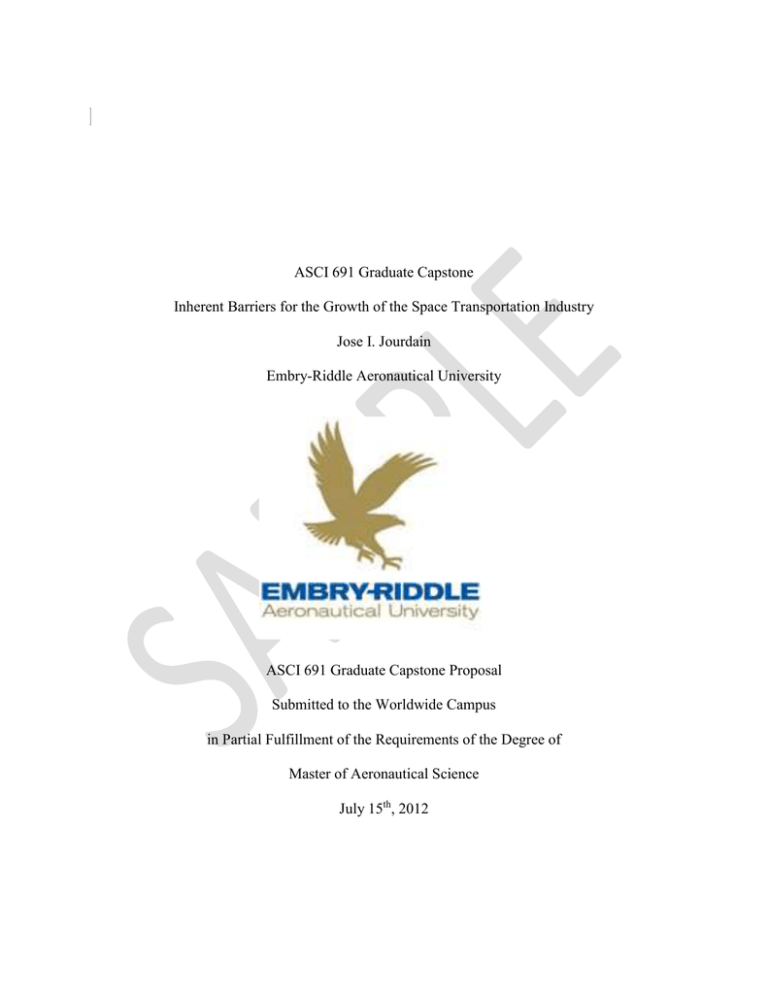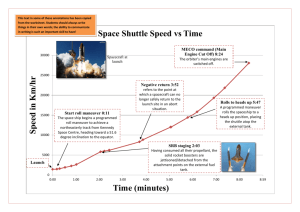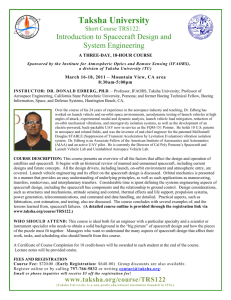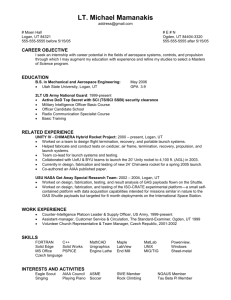SAMPLE ASCI 691 Graduate Capstone Inherent Barriers for the
advertisement

ASCI 691 Graduate Capstone Inherent Barriers for the Growth of the Space Transportation Industry Jose I. Jourdain Embry-Riddle Aeronautical University ASCI 691 Graduate Capstone Proposal Submitted to the Worldwide Campus in Partial Fulfillment of the Requirements of the Degree of Master of Aeronautical Science July 15th, 2012 Abstract Space transportation has come a long way in the past fifty years, fostering tangible technological achievements for the benefit of mankind, and gradually changing our way of life. Commercial space transportation on the other hand, which formally started in 2004 (NASA, 2012), has much ground to gain in terms of development and sustainability. Investment in spacecraft designs, certification of spaceports and vehicles, regulatory and legal hurdles, and funding from private sources are just some of those factors which will be examined by using primary data in the form of interviews conducted with industry experts, and through analysis of secondary data such as key NASA and FAA publication, and employees of aerospace consulting companies. The project will also analyze socio-political and human factors involved in the application of new technology, and the sub-problems the industry will encounter, which will be detailed under the barriers section of this project. The researcher will utilize a quantitative methodology by investigating the relationship between the results obtained using inferential statistics, such as correlations effect, as well as descriptive analysis of both primary and secondary aerospace industry sources. The specialization is addressed in this individual project with meeting Program Outcome 11. Keywords: barriers for sustained growth, space transportation industry, spacecraft designs, certification of spaceports, private investment, regulatory and legal hurdles Proposal Inherent Barriers for the Growth of the Space Transportation Industry Barriers for Growth The project may identify current socio-political and financial conditions that might prevent a sustained growth for the commercial space transportation industry in the next thirty years. New technological concepts such as composite materials and hybrid rocket motors will also be identified in order to ascertain if the logical barriers might be offset by the availability of these technological breakthroughs. The reader should gain a better understanding of all the different financial, technological and regulatory factors that might affect a sustained growth for this industry, and other sub industries, such as space tourism. First, a brief definition of the commercial space industry will be rendered, as well as basic activities which depend from it. Next the nature of the problems to be considered as samples will be discussed, via interviews of industry experts, results which will influence the researcher’s conclusions. Finally recommendations about the future of the industry for the next thirty years will be given based on the aforementioned primary and secondary industry data. Through the analysis of the following sub-problems, the researcher will first identify the logical barriers via accepted evidence; and through the project outcome, make an effort to demonstrate how these barriers might be overcome: 1. The first subproblem is safety. This has always been the predominant factor when sending humans into space. If civilians were to be considered, a more comprehensive and detailed approach would need to be presented to the public due to legal issues and third party risks to innocent bystanders. As well as risks linked to direct participation in the space program, such as those related to launch, re-entry and other elemental risks, such as radiation. More so if the number of civilians to go into space gradually increases over time. 2. The second subproblem is security. This has been a variable since the start of the space program, considering that initial missions were developed during the Cold War, and security played a central role, providing a strategic military advantage over other nations. Today, the motivation is different and is a legitimate concern for countries like the United States, due to malicious acts that might be planned by terrorists on a growing space transportation industry (ITAR, 2012).1 3. The third subproblem is financial. The cost of every space mission has traditionally been extremely high. From the manufacturing of the crafts, cost of fuel and training, to the ground personnel required to support the missions. According to NASA (2012), the average cost to launch a space shuttle was about $450 million dollars per mission, and according to Sellars (2008), the launch can sometimes account for nearly 30% of a mission’s cost. Therefore, if we take the above estimate given by NASA of $450 million, then 30% of the general cost would render a launch cost of $135 million dollars per mission. This is just for the launch part of the mission; without considering manufacturing and testing, or communications and mission operations. 4. The fourth subproblem is physical & mental fitness. Due to the characteristics of the space environment, from the effects of zero gravity to the mental aptitude for launch and re-entry procedures, rigorous training has always been enforced by the space agencies to guarantee the success of the missions (Clement, 2008). The same approach should also be considered for ordinary civilians as the industry grows, since the latter might represent basic physiological and psychological problems for the selection of would-be civilian tourists. Therefore, an assessment 1 current configuration of the International Traffic in Arms Regulations ("ITAR") creates a significant impediment to private industry's ability to reach international markets, as there can be major delays in getting approval for exports. This policy is "disconnected from program requirements and the reality of international space activity”.The obstacle effectively bars smaller entrepreneurial companies from participating in this market at all, which adversely affects the amount of diversity in innovation. to each candidate must be made by the respective space transportation companies to avoid liabilities and other legal consequences that might arise. 5. The fifth subproblem is the available technology and the willingness to share the knowledge. Technology has taken giant leaps since the start of the space program and this variable is turning in our favor with each passing generation. The true setback has been the limitation of governments and nations to share breakthrough technologies with the private sector. The process is stagnant and is only available years later (Handberg, 1995). 6. The sixth subproblem is legal. All operational activities of this industry is subject, and will continue to be subject, to legal, regulatory, liability, insurance and environmental factors.2 2 A committee from the American Bar Association is currently drafting the legal framework for their members on the space transportation industry, to be presented in August 2012 at the ABA Conference in Chicago (ABA, 2012). Abstract Technological advances in today’s aerospace industry have placed us in a very unique and interesting time in human history, for we have the opportunity to expand our overall involvement in space. Nonetheless, we are also facing tangible challenges which must be seriously contemplated if we are to move forward to a sustainable growth of the commercial space transportation industry. Investment in spacecraft designs, certification of spaceports and vehicles, regulatory and legal hurdles, and funding from private sources are just some of those factors that have been examined by using primary data in the form of interviews conducted with industry experts, and through analysis of secondary data such as key NASA and FAA publications, and employees of aerospace consulting companies. The project also analyzed socio-political and human factors involved in the application of new technology. Keywords: barriers for sustained growth, space transportation industry, spacecraft designs, certification of spaceports, private investment, regulatory and legal hurdles, Challenges TABLE OF CONTENTS Page ABSTRACT……………………………………………………………….15 LIST OF TABLES…………………………………………………………18 LIST OF FIGURES………………………………………………………..19 Chapters I INTRODUCTION Statement of the Problems …………………………………20 II REVIEW OF RELEVANT LITERATURE Part I: PEST Analysis Political…………………………………………………..…25 Environmental……………………………………………...28 Social…………………………………………………….…38 Technological…………………………………………….…39 Part II: Commercial Development of Space Orbital and Sub-Orbital Trends..…………………………….40 Spacecraft Designs..………………………………………….46 Enabling Technologies…………………………………….…51 Spaceports………….………………………………………...57 Space Tourism ……………………………………………….60 Part III: Other Challenges Facing the Commercial Industry Legal …………………………………………………………63 Safety ………………………………………………………..64 Regulatory…………………………………………………..…65 Licensing………………………………………………………68 III METHODOLOGY Participants…………………………………………………….71 Assessment instrument…………………………………………72 Test Reliability and Validity….......……………………………72 Procedure……………………………………………………….73 IV RESULTS Survey analysis and discussion…………………….…………..73 Reaction time analysis and discussion….………………………83 V CONCLUSION Conclusion………………………………………………………84 Hypotheses……………….……………………………………. 85 Recommendations………………………………………………87 REFERENCES…………………………………………………………………89 APPENDIX A – Interview questionnaire……………………………………….93 APPENDIX B – Solicitation script……………………………………………..100 APPENDIX C – Consent form………………………………………………....101 LIST OF TABLES Table Page 1. Major Exhaust Products During and After Rocket Launch………………… 30 2. Licensed Spaceports in the United States……………………………………59 3. Factorial ANOVA Data Table for Reaction Time…………………………… LIST OF FIGURES Figure Page 1. Hybrid Rocket Motor……………………………………………………. 22 2. Acid-Producing Chemicals…………………………………………….…32 3. Flora & Fauna Study around Launch Site………………………………..33 4. Rocket noise and vibration affected areas………………………………..36 5. Pyramid with expected traffic of Aviation/Aerospace flights for the next 30 years………………………………………………………….45 6. Orion Capsule for Orbital and Deep Space missions…………………….46 7. Preliminary trajectory of a sub-orbital flight…………………………….48 8. Lynx Concept “X” Vehicle for Horizontal takeoff Horizontal Land (HTHL)………………………………………………..49 9. SpaceShipTwo Concept “X” for Horizontal takeoff Horizontal Landing (HTHL)…………………………………….50 10. New Sheppard Vehicle Concept “Z” for Vertical takeoff Vertical Landing (VTVL)……………………………………….50 11. Licensed Spaceports in the United States……………………………….57 12. Percentage of accidents/fatalities during phases of flight……………….67 13. Mean One Tail/Two Tail Hypothesis Test for Conducted Survey……...72 14-23 Results from surveys conducted…………………………………….74-82 Inherent Barriers for the Growth of the Space Transportation Industry Project Introduction Statement of the Problem Since Konstantin Tsiolkovsky, father of Russian cosmonautics, first calculated in 1880 the escape velocity required for journey beyond earth’s atmosphere, and suggested that burning a combination of liquid hydrogen and liquid oxygen could improve rocket efficiency, humans have long desired to achieve the goal of spaceflight. In the 1960’s humans started to venture into space through various missions, and since then the process has been conducted through the use of rockets as the principle mean of transport. Today, placing a spacecraft into orbit requires a great amount of logistics, facilities, and of course, personnel. Through this report, the author will put forth new technological breakthroughs, such as composite materials and hybrid rocket motors and how they represent important steps in the right direction to achieve a long term sustainable growth for the commercial space transportation industry. Nonetheless, as the researcher will prove in this report, the commercial side of this industry is still in its infancy; thus, multiple barriers will become evident to the reader, barriers which must be fully assessed and overcome in order for this industry to become sustainable.







